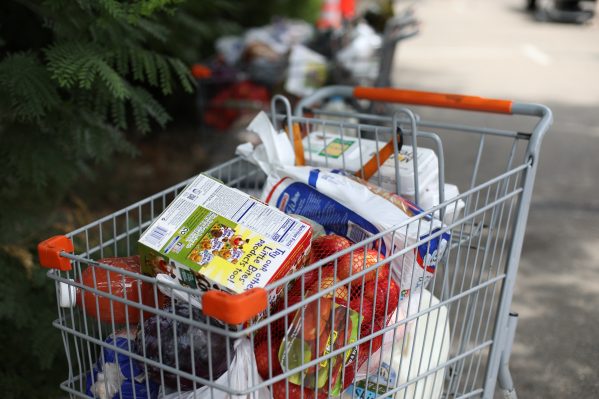
Hunger Awareness Information
Though C.A.N.S. Around the Oval has been around for 36 years, and its impact continues to enhance in size and reach each year, there is still a great need for this program to continue to grow. Below are recently added, current, and relevant definitions, facts and figures, and narratives about food insecurity that provide context and give life to the immediate needs of our surrounding communities, and beyond.
- Hunger: is a condition in which people do not get enough food to provide the nutrients for fully productive, active lives. Individuals may lack money for food or to maintain a balanced diet, cut meal sizes, or skip meals to stretch the food they have, or go hungry. Hunger and poverty are inextricably linked. (Food Bank for Larimer County). Hunger is the distress associated with lack of food. The threshold for food deprivation, or undernourishment, is fewer than 1,800 calories per day. (Action Against Hunger)
- To learn more about the food bank’s focus on local hunger and hunger’s impact on health, click here.
- Food Insecurity: broadly defined is “the state of being without reliable access to sufficient quantity of affordable, nutritious food.” Indicators of food insecurity include skipping meals due to lack of financial resources, cutting the size of meals due to lack of financial resources, experiencing hunger but not eating, the inability to afford balanced meals, and/or running out of food at the end of a pay period.” (SOURCE: CSU News – Food for Fines Reduces CSU Parking Fees and Provides Meals for Hungry Students))
- Food Justice: focuses “on increasing access to health, affordable, and culturally-appropriate food,” often “through empowerment strategies to get low-income communities involved with urban-agriculture.” (Food Justice Now! Deeping the Roots of Social Struggle, CSU Associate Professor, Joshua Sbicca, 2018)
- Food Security: a food secure household means access by all members, at all times, to enough food for an active, healthy life. At a minimum, it includes: (1) the ready availability of nutritionally adequate and safe foods and (2) assured ability to acquire acceptable foods in socially acceptable ways – as in, without resorting to emergency food supplies, scavenging, or other coping strategies. (Economic Research Service – United States Department of Agriculture)
- Undernourishment: the threshold for food deprivation is fewer than 1,800 calories per day. It goes beyond calories to signify deficiencies in energy, protein, and/or essential vitamins and minerals. (Action Against Hunger)
CSU Campus:
- “A #RealCollege survey given to CSU students during January 2020 revealed that 32% of the student body face food insecurity at some level.” (Michael Buttram, Basic Needs Program Manager, SLiCE)
- “If it were not for C.A.N.S. Around the Oval each fall where thousands of dollars and pounds of non-perishable/canned foods come to the Food Bank for Larimer County, we could not as much focus our efforts on securing and providing perishable food items [as in fruits, vegetables, dairy, and baked goods] as we do to our Food Share program and CSU’s Mobile Food Pantry. They work in tandem, and we cannot do what we do without events like C.A.N.S. Around the Oval.” (Emily Schwartz, former Community Engagement Coordinator, Food Bank for Larimer County)
Larimer County: (Food Bank for Larimer County)
- 10.9% of Larimer County residents live at or below the Federal Poverty Line
- 38,040 Larimer County residents are food insecure
- 8.4% of senior citizens are food insecure
- 21.6% of single mothers live in poverty
- 32% of school aged children in Larimer County receive free or reduced meals
“If may be surprising to know that over 1 in 3 children in Larimer County is food insecure, meaning they are either currently hungry or nearing hunger.” – Food Bank for Larimer County
“The face of hunger may surprise you: 33% are children, 7.7% are Seniors, 49% are Working.” -Food Bank for Larimer County
“After steadily declining for a decade, world hunger is on the rise, affecting nearly 10% percent of people globally. From 2019 to 2022, the number of undernourished people grew by as many as 150 million, a crisis driven largely by conflict, climate change, and the COVID-19 pandemic.” -Action Against Hunger
“Around the world, more than enough food is produced to feed the global population—but as many as 828 million people still go hungry.” – Action Against Hunger
“In 2021, 53 million people turned to food banks and community programs for help putting food on the table.” – Feeding America
“According to the USDA, more than 34 million people, including 9 million children, in the United States are food insecure” – USDA and Feeding America
United States: (Feeding America)
- “More than 54 million people and 18 million children in the United States will experience food insecurity in 2020 as a result of COVID-19.”
- “Children who face hunger are subject to long term setbacks. When starting school children that face hunger are more likely to repeat a grade, have social and behavioral problems as well as have developmental impairments in their language and motor skills.”
- “Rural and farming communities work hard to produce food to feed all our families while disproportionally facing high rates of hunger. These counties constitute 87% of counties with the highest rates of food insecurity despite only making up 63% of U.S. counties.”
- “Hunger in African American communities is an extremely prevalent issue. In counties with the highest food insecurity, 8 out of the top 10 have large populations of African Americans, with at least 60% of the population. Additionally, they have more than twice the risk of facing hunger than white, non-Hispanic households.”
Globally:
- “Hunger has grown significantly in 2020 due to COVID-19. It increased the number of people facing food insecurity by 83 million to 132 million; with the number of people impacted by hunger at 690 million in 2019 this will be nearly a 1/6 increase.” (Food and Agriculture Organization of the United Nations)
- “At one point there were 30,000 edible plants in the world. Contrasted with today where 66% of total crops produced are only nine species of plants, it shows a large need to grow a variety of food, not only to nourish people but to sustain the Earth.” (Food and Agriculture Organization of the United Nations)
- “The amount of food already produced around the world is enough to provide food to the whole planet.” (Action Against Hunger)
- “Small farmers, herders, and fishermen produce about 70 percent of the global food supply, yet they are especially vulnerable to food insecurity – poverty and hunger are most acute among rural populations.” (Action Against Hunger)
FOOD BANK FOR LARIMER COUNTY (FBLC) – LOCAL CLIENT NARRATIVES
- Alisha’s (Husband’s) Story -“I think the best thing about the Food Bank is that it made us feel hopeful and lucky to have an organization here in Larimer County serving people in need and managing its resources effectively by providing quality food which could otherwise go to waste. This “hand-up” made all the difference for us to live free of fear during a period of crucial growth. Being treated respectfully in our time of need not only grew our gratefulness to our new community but also our empathy and respect for others in need. We work hard to bring value to our community, regardless of how much money it brings us, and now that we’re back on our feet we can continue to do so thanks to our Food Bank.”
- Janel’s Story -“Growing up in such isolation and being taught to mistrust the outside world, I was very moved that there was a place that would offer this kind of help to me and my family. The quality of the food provided is amazing, we love the fresh produce, the brown rice and the whole grains. I’m so inspired by the volunteers who give their own time to help. It feels good to know my family and I are not alone and that there are people who care.”
- Marisela, a mother of three, is like so many parents who turned to the Food Bank when COVID-19 hit. “I thank the food bank for giving us the help when we need it most,” she says. “We struggled with three months of uncertainty and quarantine. Many families without jobs – we were one of them.” Marisela says the situation was compounded by her children being out of school. “It was a very difficult time for us. Thanks to the food bank, not a day was missing a plate of food in my home. Blessings for you, the volunteers, who always treated us with kindness. Infinite thanks.”
- Thomas is a social worker employed by the Department of Veterans Affairs. As part of their outreach program, Thomas shops at the Food Bank on behalf of his client Patrick, a mentally ill veteran in his 60s who is now homebound as a result of the pandemic. “I’m thankful that I have a resource here in town to help Patrick get the food he needs to survive,” says Thomas.
- “I have always been that mom who buys extra food to donate whenever I saw a donation box or center. Our family has been lucky enough to have enough, and enough to share. This year, like many, many other families we were impacted by the pandemic. We had to quickly adjust to a new way of life, and that included not having as much for shopping until other sources came through. I appreciate that The Food Bank of Larimer County came up with the drive-through food pick-up. I was initially super embarrassed to be taking advantage of the resource, and nervous I’d be made to feel like a heel for taking from this resource. The opposite was true, everyone was absolutely kind and caring, and I truly felt the love of the community,” said Lizzy.
- For other written stories and video narratives of local hunger, read more of the Food Bank’s Stories of Hunger.
CIVIL EATS – U.S. BASED PANDEMIC ARTICLES
Civil Eats is a non-profit news source and organization providing critical perspectives about the food system in the United States. They focus on the evolving food landscape and sustainable agriculture to build more economical and socially just communities.
- College Food Pantries Are Reinventing Ways to Feed Students – “As universities closed nationwide, many food-insecure students fell through the cracks. Staff and administrators are working to ensure they get fed.” (7/2020)
- Edible Education Goes Online in the COVID Era – “As the school year starts in the most of uncertain of times, these food and garden classes enter new virtual territory.” (9/2020)
- Food Distribution 101: What Happens When the Food Supply is Disrupted by a Pandemic – “As farmers are forced to dump food and food banks are struggling to feed millions, an explainer on U.S. food supply and distribution.” (4/2020)
- How the Pandemic is Affecting Home Food Waste – As people are cooking more than ever before, an expert offers tips on how to waste less food. (5/2020)
- Want to Fight Rising Food Insecurity? Listen to People Who’ve Been Hungry – “As families face sudden, chronic food shortages, three researchers share lessons from hundreds of interviews with the food insecure.” (5/2020)

